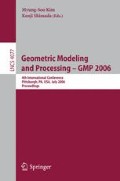Abstract
This paper presents an algorithm to generate a smooth surface between two closed spatial spline curves. With the assumption that the two input curves can be projected to a single plane so that the projections do not have any mutual or self intersections, and so that one projection completely encloses the other. We describe an algorithm that generates a temporal deformation between the input curves, one which can be thought of as sweeping a surface. Instead of addressing feature matching, as many planar curve deformation algorithms do, the deformation method described generates intermediate curves that behave like wavefronts as they evolve from the shape of one boundary curve to a medial type curve, and then gradually take on the characteristics of the second boundary curve. This is achieved in a manner that assures there will be neither singularities in the parameterization nor self-intersections in the projected surface.
Access this chapter
Tax calculation will be finalised at checkout
Purchases are for personal use only
Preview
Unable to display preview. Download preview PDF.
References
Balch, T., Hybinette, M.: Social potentials and scalable multi-robot formations. In: ICRA (2000)
Blanchard, P., Devaney, R., Hall, G.: Differential Equations. International Thomson Publishing Inc. (1998)
Caselles, V., Kimmel, R., Sapiro, G.: Geodesic active contours. International Journal of Computer Vision 22(1), 61–79 (1997)
Chuang, J.: Potential-based modeling of three-dimensional worksapce for obstacle avoidance. IEEE Transactions on Robtics and Automation 14(5), 778–785 (1998)
Cohen, S., Elber, G., Yehuda, R.: Matching of freeform curves. Computer Aided Design 29(5), 369–378 (1997)
Curless, B., Levoy, M.: A volumetric method for building complex models from range images. In: Proceedings of SIGGRAPH 1996, pp. 303–312 (1996)
Davis, J., Marschner, S., Garr, M., Levoy, M.: Filling holes in complex surfaces using volumetric diffusion. In: Proceedings of the First International Symposium on 3D Data Processing, Visualization and Transmission (3DPVT 2002), June 2002, pp. 428–438. IEEE Computer Society, Los Alamitos (2002)
de Berg, M., van Kreveld, M., Overmars, M., Schwarzkopf, O.: Computational Geometry: Algorithms and Applications. Springer, Heidelberg (1997)
Elber, G.: Metamorphosis of freeform curves and surfaces. In: Computer Graphics International 1995, June 1995 pp. 29–40 (1995)
Ge, S., Cui, Y.: New potential functions for mobile path planning. IEEE Transactions on Robotics and Automation 16(5), 615–620 (2000)
Goldstein, E., Gotsman, C.: Polygon morphing using a multiresolution representation. Graphics Interface, 247–254 (1995)
Gotsman, C., Surazhsky, V.: Guaranteed intersection-free polygon morphing. Computers and Graphics 25, 67–75 (2001)
Kass, M., Witkin, A., Terzopolous, D.: Snakes: Active contour models. International Journal of Computer Vision 1(4), 321–331 (1988)
Lewis, J., Weir, M.: Using subgoal chaining to address the local minimum problem. In: Proceedings of Second International ICSC Symposium on Neural Computation (2000)
Martin, W., Cohen, E.: Surface completion of an irregular boundary curve using a concentric mapping. In: Fifth International Conference on Curves and Surfaces (June 2002)
Sederberg, T., Gao, P., Wang, G., Mu, H.: 2d blending shapes: An intrinsic solution to the vertex path problem. In: Proceedings of SIGGRAPH 1993, vol. 27, pp. 15–18 (1993)
Sederberg, T., Greenwood, E.: A physically based approach to 2d shape blending. Computer Graphics 26(2), 25–34 (1992)
Tsai, A., Yezzi, A., Willsky, A.: Curve evolution implementation of mumford-shah functional for image segmentation, denoising, interpolation, and magnification. IEEE Transactions on Image Processing 10(8) (August 2001)
Xu, C., Prince, J.: Snakes, shapes, and gradient vector flow. IEEE Transactions on Image Processing 7, 359–369 (1998)
Author information
Authors and Affiliations
Editor information
Editors and Affiliations
Rights and permissions
Copyright information
© 2006 Springer-Verlag Berlin Heidelberg
About this paper
Cite this paper
Daniels, J., Cohen, E. (2006). Surface Creation and Curve Deformations Between Two Complex Closed Spatial Spline Curves. In: Kim, MS., Shimada, K. (eds) Geometric Modeling and Processing - GMP 2006. GMP 2006. Lecture Notes in Computer Science, vol 4077. Springer, Berlin, Heidelberg. https://doi.org/10.1007/11802914_16
Download citation
DOI: https://doi.org/10.1007/11802914_16
Publisher Name: Springer, Berlin, Heidelberg
Print ISBN: 978-3-540-36711-6
Online ISBN: 978-3-540-36865-6
eBook Packages: Computer ScienceComputer Science (R0)

